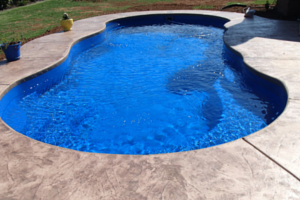.png?width=600&name=Blog%20Update%20CL%20(1).png)
When choosing a pool, the options can seem overwhelming. Weighing the pros and cons to different styles can take significant effort. To help you understand what pool best fits your lifestyle, we’ve put together a simple comparison of above ground pools vs fiberglass pools vs concrete pools. We’ve rated each style on a 1-5 scale for longevity, cost and convenience so you can decide which factors are most important to you.
(Like what you're reading? Check out "The Essential Guide to Above Ground Pools.")
Above Ground Pools

Longevity: 2*
The longevity of an above ground pool is a two-sided coin. These pools will not last forever. For some, this may go in the “con column.” For others, it is much easier to commit to a shorter period of pool ownership. On average, an above ground pool will last 8-15 years before you will want to look at replacing it. Many pool owners find this to coincide well with raising children.
Convenience: 4*
Because fiberglass pools are created in a factory, they are the fastest in-ground option. Installation can take place in as little as 10 days. As mentioned, a big advantage is that they don’t need care like replacing vinyl liners or resurfacing concrete.
Cost: 5*
Above ground pools have the lowest cost of entry. As little as $3,000 will get you swimming. A large additional cost to consider is decking. However, you can always add a deck later once you have paid off the cost of the pool or finance both together.
Fiberglass Inground Pools

Longevity: 4*
Fiberglass pools can easily last 20+ years. The best part of their longevity is that there is no vinyl liner to replace/repair and they do not require resurfacing like concrete pools.
Cost: 4*
While fiberglass pools are more expensive than above ground pools, when accounting for the lifetime of the pool, they can be cheaper per year. A fiberglass pool can be almost as expensive as a concrete pool but they don’t need resurfacing. That means the initial cost will cover more years without worry for upcoming cost.
Convenience: 4*
Because fiberglass pools are created in a factory, they are the fastest in-ground option. Installation can take place in as little as 10 days. As mentioned, a big advantage is that they don’t need care like replacing vinyl liners or resurfacing concrete
Concrete Inground Pools
Longevity: 5*
Concrete pools are built to last. However, that longevity comes at a price and concrete will need to be resurfaced every 10 years.
Cost: 2*
The cost of concrete pools varies greatly. Entry level options start in the range of $30k-$70k. When the time comes to resurface the concrete, you should also expect it to cost at least $8k.
Convenience: 3*
Concrete pools take a much longer time to install. 45-75 days is fairly typical. This includes about a month for the concrete to cure before filling the pool. Resurfacing your concrete is quite the chore but can be done in months outside the swimming season. More cleaning and chemicals are also required because of the pores in the walls.
Pools with Vinyl Liners

Longevity: 3*
On average a vinyl liner will last between 7 and 15 years at a replacement expense of $2,500-$3,500 plus the cost of water.
Cost: 2*
Vinyl Liner Pools have the lowest initial cost of any of the inground pools. The majority of vinyl liner pool installations in most parts of the United States fall in the 20-40k range.
Convenience: 4*
Once the permits are obtained, installation can typically take anywhere from 2 to 5 weeks. Some factors such as weather and township inspections can affect the length of construction.









.png?width=263&name=May%20%20CL%20%20(1).png)